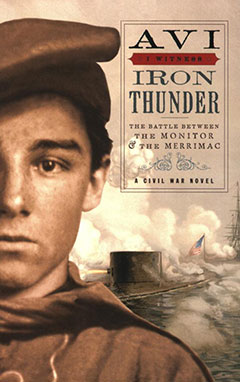If you enjoy reading history—as I do—it’s easy to also develop a fascination for the things, the artifacts of history. Napoleon’s hat. Jane Austin’s tea cup. Museums provide much of that, illustrated biographies add more, and there are books with titles such as The History of World War One in One Hundred Objects. I just purchased A History of American Sports in One Hundred Objects for one of my sons.
Over the years I’ve come to know that young people, boys in particular, are fascinated by things, too, whether it be a Colt revolver, or Benjamin Franklin’s eye-glasses.
It was these kinds of interests that led me to create what I hoped would be a series called I Witness. The notion was to write historical fiction with as much accuracy as I could, and insert a young person into that reality. Then I would have the book illustrated with historical documents—pictures of things—old painting and etchings—to illuminate the story.
The story of the Civil War ironclad The Monitor, and its battle with the Confederate Merrimac, had always fascinated me. To read the facts of that momentous event—and the events leading up to it—is like reading a thriller.
So it was I came to write Iron Thunder, which tells the story of the battle. A research visit to The Mariners’ Museum in Newport News, Virginia, proved captivating. Here were many artifacts from The U.S.S. Monitor itself, as well as engaging exhibits about the battle. Here, too, was the log of the Monitor, as well as letters written by the crew.
At the time no one quite knew how an iron ship would function in battle. Would it float? Would it survive a battle? In the archives, I can recall vividly reading the original letters that one of the seamen (he was a coal-shoveler on the Monitor) wrote home to his mother, the day after the battle. “Mom, it was as if they were shooting spitballs at us.” Wow! Research gold. No surprise—that statement is in the book.
My task as a writer was to take the known facts—much has been written about this event—and shape it into a story that would engage and inform my readers. It helped to discover that there was a cabin boy on the ship by the name of Tom Carroll. I borrowed his name and told his (invented) story.
I once had a conversation with the writer Paula Fox. “The job of the writer,” she told me, “is to imagine the truth.”
The job I had as the writer of Iron Thunder was not to imagine the truth. All of that was laid out before me. My job was to give that truth life.


1 thought on “Story Behind the Story #52: Iron Thunder”
Wonderful story. I research history. My fervent wish to be locked in the National Archives, Washington over night. Oh, heaven.